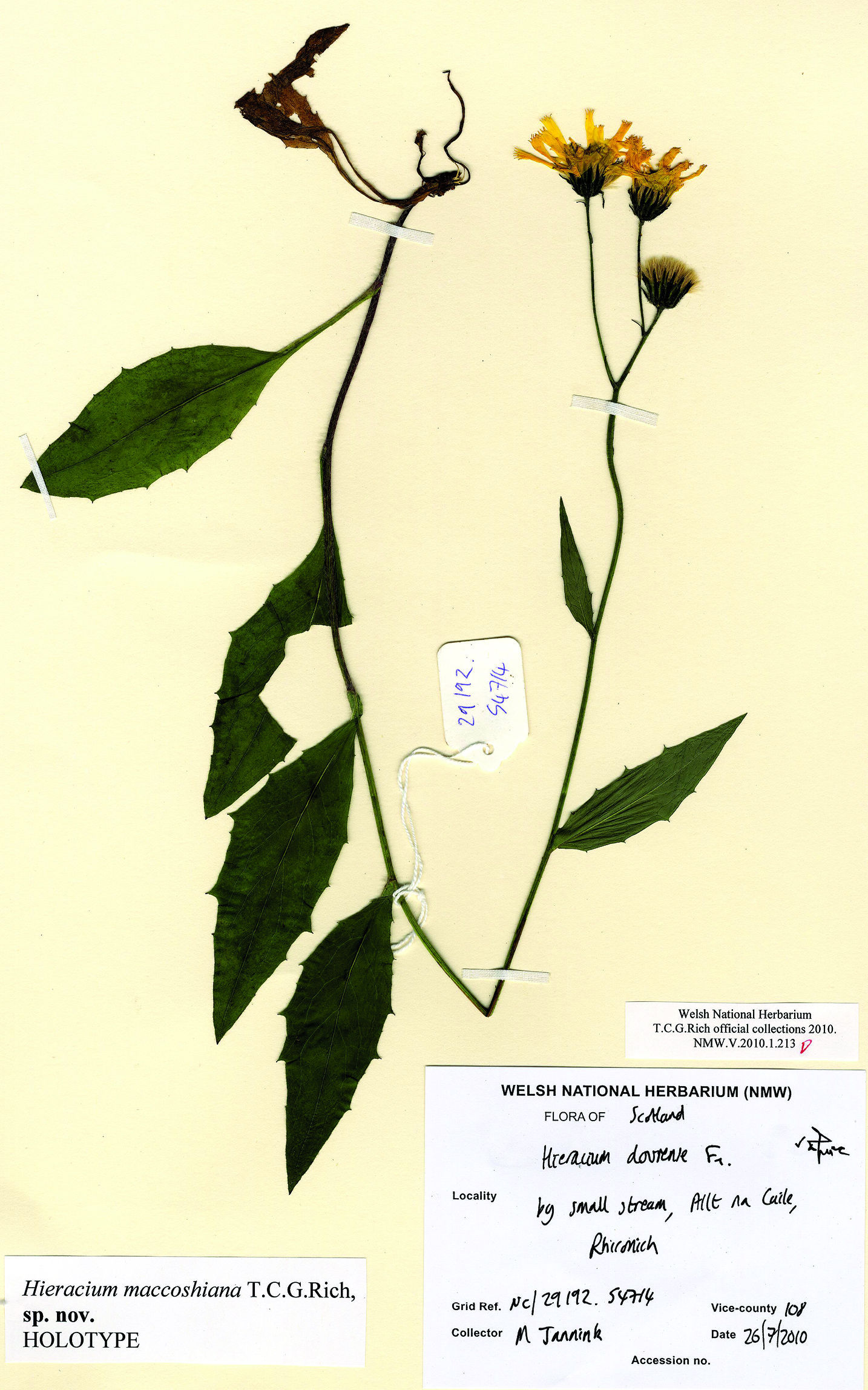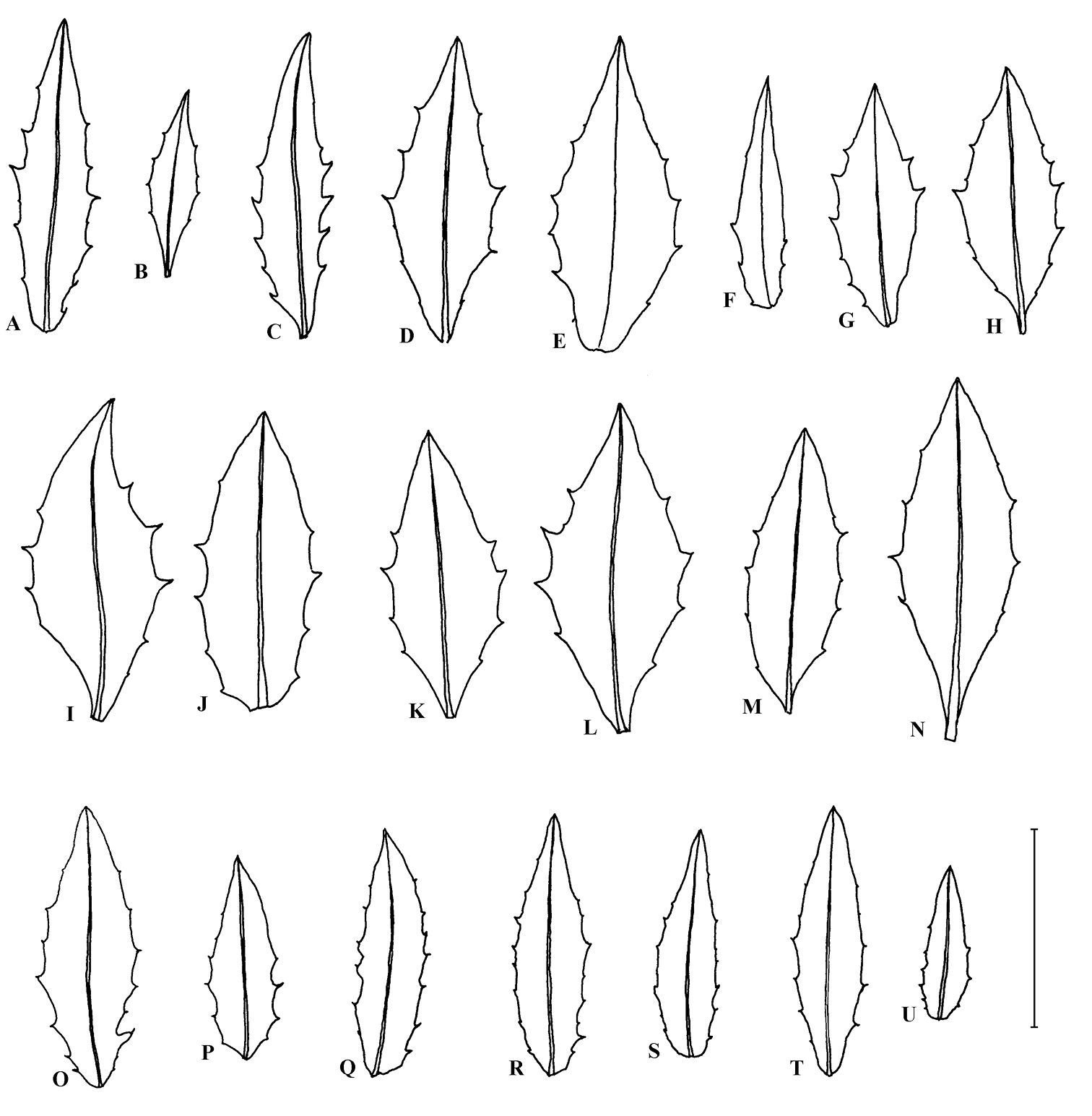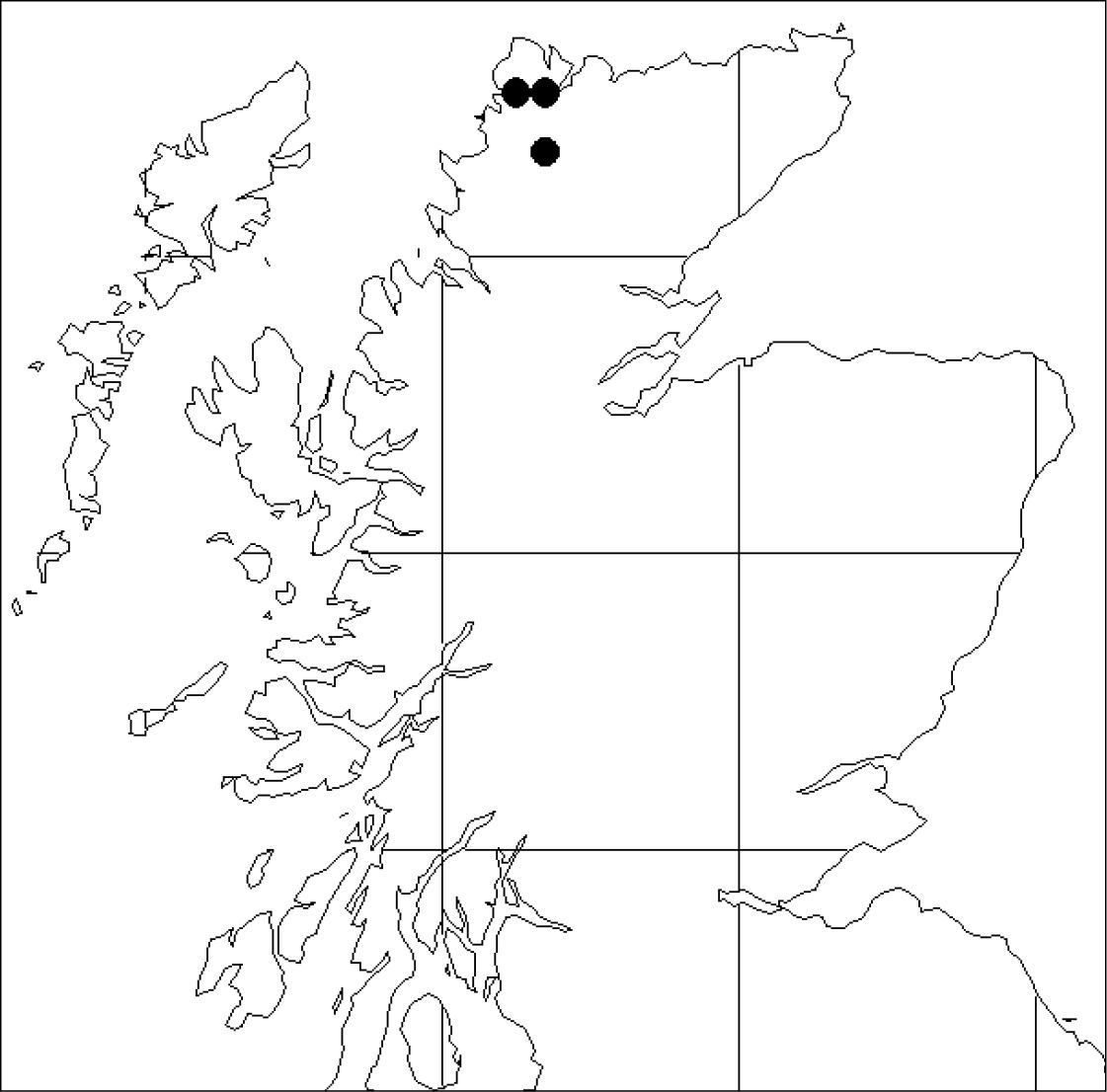






(C) 2011 Timothy C. G. Rich. This is an open access article distributed under the terms of the Creative Commons Attribution License, which permits unrestricted use, distribution, and reproduction in any medium, provided the original author and source are credited.
For reference, use of the paginated PDF or printed version of this article is recommended.
A new species of hawkweed Hieracium maccoshiana T.C.G.Rich sp. nov. is described. It is related to the Norwegian Hieracium dovrense Fr., but differs in the shape and toothing of the stem leaves and in having glabrous-tipped ligules. It is endemic to the county of Sutherland, Scotland where it has been recorded from four sites. A lectotype of Hieracium dovrense is designated.
Asteraceae, dovrense, Endangered, Hieracium, lectotype, maccoshiana, new species, Norway, Scotland, Section, Alpestria
In 1897, E. S. Marshall and W. A. Shoolbred collected a
hawkweed from rocks on the north side of Ben Loyal, Sutherland,
Scotland, which they attributed to the Norwegian species, Hieracium dovrense Fr. (
Hieracium dovrense Fr. was described by E. M. Fries in 1848 from several alpine localities in Norway, particularly in the Dovre area (
In 2005, D. McCosh suggested that I should visit one of the Rhiconich sites to see if Hieracium dovrense was still present, and further visits were carried out in 2010 as part of a revision of Hieracium section Alpestria (Fr.) Arv.-Touv. in Britain. During this work I compared the Sutherland plants against a specimen in BM cited in
Material from Sutherland and of Norwegian Hieracium dovrense was studied in the field in 2010 (see Supplementary file 1; Hieracium dovrense
survey 2010; vouchers in NMW) and in the following herbaria in detail:
MANCH, NMW, S and UPS. In addition, material from BM, CGE and E was
also consulted. A description was drawn up following the format of
The number of leaves on the stem is an important character in section Alpestria, but different taxonomists do not adopt a consistent method of counting leaves. The problem arises as leaves on the stem with inflorescences in their axils can also be termed bracts, which may or may not be counted. Furthermore, although there is a gradual transition from stems leaves to bracts, the smallest bracts at the top of the main stem may differ markedly in shape from the lower leaves and may be included or excluded. Here, all leaves and inflorescence bracts on the main stem are counted.
Taxonomic treatment Lectotype of Hieracium dovrense Fr.urn:lsid:ipni.org:names:77111568-1
http://species-id.net/wiki/Hieracium_maccoshiana
Figs 1, 2 D–NRosula basalia sub anthesi fere absenti. Foliis caulinis 4–8 ellipticis dentibus magnis. Pedunculis pilis multis stellatis pilis eglandulosis simplicibus multis pilisque glandulosis paucis. Bracteis involucralibus 2–2.5 mm latitudinis pilis stellatis paucis pilis eglandulosis simplicibus multis pilisque glandulosis multis. Ligulis apice glabris. Stylis obscuris.
Holotype: Scotland. Sutherland: by small stream, Allt na Cuile, Rhiconich, 58.4470, -4.9300, 150 m alt., 26 July 2010, M. Jannink (NMW, accession number V.2010.1.213).
Holotype of Hieracium maccoshiana (NMW).
Description. Stem to 50 cm, pale green,
slightly purple–tinted below, slender to fairly robust; stellate hairs
sparse and mainly above; simple eglandular hairs long, pale, sparse
and glabrescent to dense (especially below); glandular hairs very small,
occasional; sparsely and minutely puberulous. Basal leaves absent or
withering before or up to flowering time or rarely persistent, few.
Lamina elliptical or subrotund; apex obtuse–mucronulate; base attenuate;
margins remotely denticulate to coarsely dentate; with a few, pale,
medium simple eglandular hairs above and below or nearly glabrous above.
Petioles winged and broadened at base, with numerous medium to long,
pale simple eglandular hairs. Stem leaves and inflorescence bracts
(3–)4–8, 2–10 × 0.8–3.5 cm, gradually decreasing in size upwards,
pale green on upper surface, paler beneath. Lamina of the lower leaves
elliptical; apex obtuse–mucronulate to acute; base attenuate; margins
denticulate to sharply and irregularly dentate with ascending teeth;
petiole winged, semiamplexicaul. Lamina of the median leaves
elliptical; apex obtuse–mucronulate to acute; base rounded or abruptly
contracted, sessile, semiamplexicaul; margins denticulate to sharply
and irregularly dentate with large or small, ascending, mammiform
teeth. Lamina of the upper leaves lanceolate; apex acute to acuminate;
base cuneate, sessile, semiamplexicaul, margins denticulate to
shallowly dentate. All stem leaves with stellate hairs few to sparse on
both surfaces; simple eglandular hairs few to numerous below and nearly
glabrous above, pale, medium. Inflorescence usually with 2–9(–12)
capitula, rather compactly cymose. Peduncles 1–5 cm (acladium 0.3–2
cm), suberect, slender; stellate hairs sparse to dense; simple
eglandular hairs few to numerous, short to medium, dark–based;
glandular hairs few, very short, black. Capitula 20–30(–45) mm in
diameter, subtruncate at base. Involucral bracts 9–11 × (1.7–)2.0–2.5
mm (the outermost from c. 5 mm long), all linear–lanceolate,
blackish–green; apex obtuse; stellate hairs sparse, often with a tuft
at the apex; simple eglandular hairs many, short to medium,
dark–based; glandular hairs many, very short, black. Ligules yellow,
glabrous–tipped. Styles discoloured. Achenes 4.0–4.5 mm,
blackish–brown. Margins of receptacle pits long–dentate. Chromosome
number 2n = 36 (cf.
Middle stem leaves. A–C possible Hieracium maccoshiana. A–B Ben Loyal (NMW 28.131.5185). C Ben Loyal (BM). D–N Hieracium maccoshiana. D–F Rhiconich gorge (NMW V.2005.1.159). G–H Foinaven (CGE). I–L Rhiconich (CGE). M–N Craig na H’Uidhe (CGE). O–U Hieracium dovrense, Drivstua, Dovrefj, Norway (S). O–Q S09-16213. R S09-16217. S S09-16224. T–U S09-16222. Scale bar 5 cm.
Distribution. Endemic to Sutherland, Scotland, where it is known from four sites in Sutherland: in a gorge and on a burn side near Rhiconich; on a burn side in Coire Dùail, Foinaven; and on rocks at Creag na h-Uidhe (Fig. 3). The status of plants from Ben Loyal remains to be clarified when it has been refound in the field.
Distribution of Hieracium maccoshiana in Scotland.
Ecology. Mountain cliff ledges and rocks,
in rocky ravines and on riversides. It mostly occurs out of the reach
of large herbivores such as deer or sheep as, like most leafy
hawkweeds, is likely to be selectively eaten. The altitudes range from
130–414 m. It flowers from late July to August, and is probably
apomictic. Some plants may produce sparse pollen and others none (
Etymology. The epithet honours David J. McCosh for his work in mapping British and Irish Hieracium taxa over the last 30 years, and for mentoring me. The spelling ‘maccoshiana’ follows recommendation 60C.5.a of the International Code of Botanical Nomenclature (Vienna Code McNeil et al. 2006).
Conservation status. Surveys in 2010 revealed about 60 plants in four sites (see supplementary file 1: Hieracium dovrense survey 2010). It is thus best considered at
Hieracium maccoshiana is characterized by the absence of a basal rosette at flowering, the relatively few (4–8), elliptical stem leaves with large teeth, the relatively hairy peduncles, the relatively broad (2–2.5 mm) involucral bracts with few stellate hairs but many simple and glandular hairs, the glabrous ligule tips and the discoloured styles.
Hieracium maccoshiana is quite variable in hairiness and in size, with very small plants growing on dry, exposed rocks, and larger plants in sheltered situations. The basal rosettes have usually withered by flowering time but may persist when sheltered in tall vegetation. Material from Rhiconich cultivated by J. R. N. Mills became much more robust with more stem leaves with larger teeth, and developed many branches down the stem with more capitula (MANCH).
Plants from Ben Loyal tend to have slightly narrower, elliptical leaves (Fig. 2, A–C) and look more similar to Norwegian Hieracium dovrense than plants from the other populations but have glabrous ligule tips. I have provisionally grouped them with Hieracium maccoshiana but have been unable to refind them in the field yet to carry out more detailed studies.
No British species is closely allied to Hieracium maccoshiana. Four other section Alpestria species occur in mainland Scotland and England. Hieracium perthense F.N.Williams (Hieracium carpathicum auct. angl.) and Hieracium dewari Syme have many more (6–20), broader, more hairy stem leaves, narrower (1.1–2.0 mm) involucral bracts with numerous glandular hairs, and hairy tips to the ligules. Hieracium mirandum P.D.Sell and C.West has ovate to lanceolate stem leaves with more densely hairy peduncles, and narrower (1.5–2.0 mm), more sparsely hairy involucral bracts. Hieracium solum P.D.Sell and C.West has a basal rosette at flowering, a few, nearly entire stem leaves and nearly glabrous peduncles. Sixteen section Alpestria species occur in Shetland, of which Hieracium australius (Beeby) Pugsley is most similar to Hieracium maccoshiana but has generally more (5–12) stem leaves which are more hairy on the upper surface, has larger (to c. 35 mm) capitula, and has less hairy peduncles without glandular hairs.
Hieracium maccoshiana differs from Hieracium dovrense
having elliptical middle stem leaves, typically (14–)25–40 mm wide and
2.0–2.8 times as long as wide, with few, large teeth (Fig. 2), and glabrous ligule tips. Hieracium dovrense
has elliptical to narrowly elliptical middle stem leaves 13–25 mm wide
and 2.6–3.4 times as long as wide with more, smaller teeth (Fig. 2) and ciliate ligule tips.
Unfortunately, when Fries described Hieracium dovrense, he cited the earlier name Hieracium cydonae[ii]folium Vill. as a synonym thus invalidating the name. As
Hieracium maccoshiana is a new endemic species from Scotland. It is a member of Hieracium section Alpestria and differs from Hieracium dovrense within which it has previously been included by the shape and toothing of the stem leaves and in having glabrous ligule tips. The status of plants from Ben Loyal remains to be clarified.
I would like to thank Pat and Ian Evans, Nicholas Hind, Mats Hjertson, John Hunnex, Rob Huxley, Mark Jannink, Thomas Karlsson, Theo Lloyd, David McCosh, Andy McVeigh, David Price, Walter Scott, Leander Wolstenholme and the Keepers of BM, CGE, E, K, MANCH, O, S and UPS for access to material. The map was plotted using DMAP by Alan Morton.


